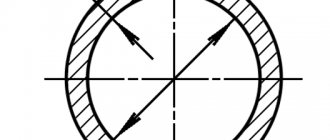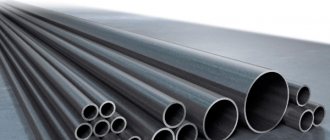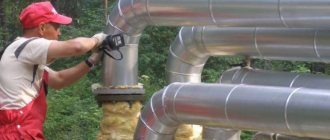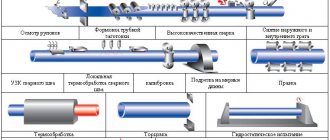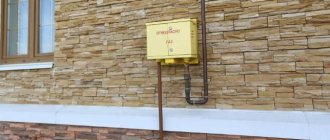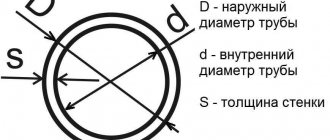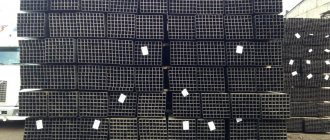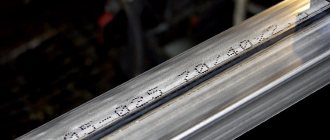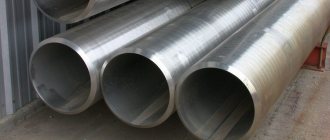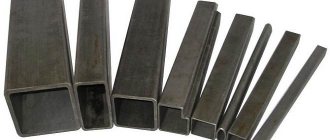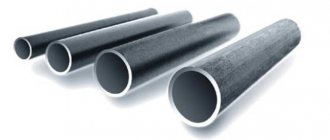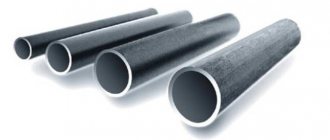GOST 3262 75 applies to galvanized and non-galvanized welded steel pipes without threads and with rolled or cut cylindrical threads. Their scope of application is water and gas pipelines, heating systems, as well as the production of parts for water and gas pipeline structures.
Welded steel pipes are used for installation of water and gas pipelines
Non-galvanized water and gas pipes: production and features
Taking into account the design features, non-galvanized water and gas pipes are the best option when laying pipelines supplying liquid or gas.
Thanks to the variety of design options, you can choose solutions to ensure supplies to domestic and industrial facilities. A reliable non-galvanized steel water and gas pipe is made of carbon steel, which is distinguished by its indicative strength characteristics. Plus - the material withstands dynamic loads well, which allows the use of VGP pipes made of black steel for transporting substances with different densities and flow rates. Experts also note the exemplary resistance to external vibration loads. Taking this point into account, non-galvanized welded steel water and gas pipes are used for laying main pipelines along ravines, bridges, overpasses and in earthquake-prone areas. Production When ordering non-galvanized steel water and gas pipes GOST 3262-75, you can additionally specify the need for threading on both ends. The approach makes it possible to reduce the time of pipeline laying in conditions where it is not possible to use electric welding. By prior agreement (if the pipe wall thickness is at least 5 mm), chamfering at an angle of 40 degrees is allowed. In this case, the end ring should remain. Important: cracks, blisters and other damage are not allowed on the surface of finished products. The ends must be processed with high quality, excluding scuffs and chips.
GOST 3262-75:
Assortment
- 1. Pipes are manufactured according to the dimensions and weight given in table. 1.
At the consumer's request, light series pipes intended for thread rolling are manufactured according to the dimensions and weight given in table. 2.
- 2. The length of the pipe is made from 4 to 12 m:
a) measured or multiple measured length with an allowance for each cut of 5 mm and a maximum deviation for the entire length plus 10 mm;
- b) of unmeasured length. By agreement between the manufacturer and the consumer, up to 5% of pipes with a length of 1.5 to 4 m are allowed in a batch of unmeasured pipes.
Table 1. Grid of parameters for steel pipes
| Conditional pass | Outside diameter | Wall thickness | Weight 1 m, kg | Number of meters per ton | ||||||
| lungs | ordinary | reinforced | lungs | ordinary | reinforced | lungs | ordinary | reinforced | ||
| 6 | 10,2 | 1,8 | 2 | 2,5 | 0,37 | 0,4 | 0,47 | 2682 | 2473 | 2016 |
| 8 | 13,5 | 2 | 2,2 | 2,8 | 0,57 | 0,61 | 0,74 | 1763 | 1631 | 1353 |
| 10 | 17 | 2 | 2,2 | 2,8 | 0,74 | 0,8 | 0,98 | 1352 | 1245 | 1020 |
| 15 | 21,3 | 2,35 | — | — | 1,1 | — | — | 910,5 | — | — |
| 15 | 21,3 | 2,5 | 2,8 | 3,2 | 1,16 | 1,28 | 1,43 | 862,7 | 782 | 700,1 |
| 20 | 26,8 | 2,35 | — | — | 1,42 | — | — | 705,7 | — | — |
| 20 | 26,8 | 2,5 | 2,8 | 3,2 | 1,5 | 1,66 | 1,86 | 667,5 | 603,4 | 536,9 |
| 25 | 33,5 | 2,8 | 3,2 | 4 | 2,12 | 2,39 | 2,91 | 471,7 | 418,2 | 343,6 |
| 32 | 42,3 | 2,8 | 3,2 | 4 | 2,73 | 3,09 | 3,78 | 366,6 | 324,1 | 264,7 |
| 40 | 48 | 3 | 3,5 | 4 | 3,33 | 3,84 | 4,34 | 300,4 | 260,4 | 230,4 |
| 50 | 60 | 3 | 3,5 | 4,5 | 4,22 | 4,88 | 6,16 | 237,1 | 205,1 | 162,4 |
| 65 | 75,5 | 3,2 | 4 | 4,5 | 5,71 | 7,05 | 7,88 | 175,3 | 141,8 | 126,9 |
| 80 | 88,5 | 3,5 | 4 | 4,5 | 7,34 | 8,34 | 9,32 | 136,3 | 120 | 107,3 |
| 90 | 101,3 | 3,5 | 4 | 4,5 | 8,44 | 9,6 | 10,74 | 118,5 | 104,2 | 93,03 |
| 100 | 114 | 4 | 4,5 | 5 | 10,85 | 12,15 | 13,44 | 92,16 | 82,29 | 74,41 |
| 125 | 140 | 4 | 4,5 | 5,5 | 13,42 | 15,04 | 18,24 | 74,54 | 66,5 | 54,81 |
| 150 | 165 | 4 | 4,5 | 5,5 | 15,88 | 17,81 | 21,63 | 62,96 | 56,14 | 46,22 |
Table 2. Dimensions, mm
| Conditional pass | Outside diameter | Wall thickness | Weight 1 m, kg |
| 10 | 16 | 2 | 0,69 |
| 15 | 20 | 2,5 | 1,08 |
| 20 | 26 | 2,5 | 1,45 |
| 25 | 32 | 2,8 | 2,02 |
| 32 | 41 | 2,8 | 2,64 |
| 40 | 47 | 3 | 3,26 |
| 50 | 59 | 3 | 4,14 |
| 65 | 74 | 3,2 | 5,59 |
Notes:
- 1. For threads made by rolling on a pipe, its internal diameter is allowed to be reduced by up to 10% along the entire length of the thread.
- 2. The mass of 1 m of pipes is calculated at a steel density of 7.85 g/cm3. Galvanized ones are 3% heavier than non-galvanized ones.
Table 3. Limit deviations for pipe sizes
| Dimensions | Limit deviations for manufacturing precision pipes | |
| ordinary | increased | |
| Outer diameter with nominal bore: | ||
| up to 40 mm incl. | +0.4 mm | ±0.4 mm |
| -0,5 | ||
| Outer diameter with nominal bore: over 40 mm | +0,8 % | ±0,8 % |
| -1 | ||
| Wall thickness | -15 % | -10 % |
Notes:
- 1. The maximum deviation in the positive direction for wall thickness is limited by the maximum deviations for the mass of the pipes.
- 2. Pipes of standard manufacturing precision are used for water supply, gas pipelines and heating systems. Pipes with increased manufacturing precision are used for parts of water and gas pipeline structures.
Maximum mass deviations should not exceed + 8%.
At the request of the consumer, maximum deviations in mass should not exceed:
- + 7.5% - for the batch;
- + 10% - for a separate pipe.
The curvature of pipes per 1 m length should not exceed:
- 2 mm - with nominal bore up to 20 mm inclusive;
- 1.5 mm - with a nominal bore over 20 mm.
Pipe threads can be long or short. The thread requirements must correspond to those indicated in the table. 4.
Table 4. Thread requirements
| Conditional bore, mm | Number of threads at nominal size | Thread length before run-out, mm | |
| long | short | ||
| 6 | — | — | — |
| 8 | — | — | — |
| 10 | — | — | — |
| 15 | 14 | 14 | 9,0 |
| 20 | 14 | 16 | 10,5 |
| 25 | 11 | 18 | 11,0 |
| 3 | 11 | 20 | 13,0 |
| 40 | 11 | 22 | 15,0 |
| 50 | 11 | 24 | 17,0 |
| 65 | 11 | 27 | 19,5 |
| 80 | 11 | 30 | 22,0 |
| 90 | 11 | 33 | 26,0 |
| 100 | 11 | 36 | 30,0 |
| 125 | 11 | 38 | 33,0 |
| 150 | 11 | 42 | 36,0 |
Pipes with a nominal bore of 6, 8, 10, 15 and 20 mm are wound into coils at the consumer’s request.
Technical requirements
- 1. Pipes are manufactured in accordance with the requirements of this standard and according to technological regulations approved in the prescribed manner, from steels in accordance with GOST 380 and GOST 1050 without standardization of mechanical properties and chemical composition.
Pipes for parts of water supply and gas pipeline structures are made of steel in accordance with GOST 1050. - 2. At the request of the consumer, the ends of pipes to be welded, with a wall thickness of 5 mm or more, must be chamfered at an angle of 35-40° to the end of the pipe. In this case, an end ring 1 - 3 mm wide should be left.
At the request of the consumer, on ordinary and reinforced pipes with a nominal bore of more than 10 mm, threads are applied to both ends of the pipe.
- 3. At the request of the consumer, pipes are equipped with couplings manufactured in accordance with GOST 8944, GOST 8954, GOST 8965 and GOST 8966 at the rate of one coupling for each pipe.
- 4. Cracks, spots, swellings and sunsets are not allowed on the surface.
Delamination is not allowed at the ends of the pipes.
Individual dents, rippling, scratches, traces of stripping and other defects caused by the production method are allowed, if they do not take the wall thickness beyond the minimum dimensions, as well as a layer of scale that does not interfere with inspection.
On pipes made by furnace welding, it is allowed to reduce the outer diameter to 0.5 mm at the seam if there is a gentle thickening in this place along the inner diameter of no more than 1.0 mm.
- 5. At the request of the consumer, on pipes with a nominal bore of 20 mm or more, the burr on the inner surface of the seam must be cut off or flattened, and the height of the burr or its traces should not exceed 0.5 mm.
At the request of the consumer, on pipes with a nominal bore of more than 15 mm, manufactured by furnace welding and hot reduction, a gentle thickening with a height of no more than 0.5 mm is allowed on the inner surface of the pipes in the weld area.
- 6. The ends of the pipes must be cut at right angles. The bevel of the end is allowed to be no more than 2°. The remaining burrs should not exceed 0.5 mm. When removing burrs, the formation of blunting (rounding) of the ends is allowed. It is allowed to cut pipes in the mill line.
By agreement between the manufacturer and the consumer, burrs up to 1 mm are allowed on pipes with a nominal bore of 6-25 mm, manufactured by furnace welding.
- 7. Galvanized pipes must have a continuous zinc coating over the entire surface with a thickness of at least 30 microns. The absence of zinc coating on the ends and threads is allowed.
On the surface of galvanized pipes, bubbles and foreign inclusions (hardzinc, oxides, sintered mixture), and peeling of the coating from the base metal are not allowed.
Individual flux spots and traces of pipes being caught by lifting devices, roughness and minor local deposits of zinc are allowed.
It is allowed to correct individual non-galvanized areas on 0.5% of the outer surface of the pipe in accordance with GOST 9.307.
- 8. Pipes must withstand hydraulic pressure:
2.4 MPa (25 kgf/cm2) - ordinary and light;
3.1 MPa (32 kgf/cm2) - reinforced.
At the request of the consumer, the pipes must withstand hydraulic pressure of 4.9 MPa (50 kgf/cm2)
- 9. Pipes with a nominal bore up to 40 mm inclusive must withstand the bend test around a mandrel with a radius equal to 2.5 outer diameters, and with a nominal bore of 50 mm - on a mandrel with a radius equal to 3.5 outer diameters.
At the request of the consumer, pipes must withstand the distribution test:
with a nominal bore from 15 to 50 mm - no less than 7%;
with a nominal pass of 65 or more - no less than 4%.
At the request of the consumer, pipes must withstand the flattening test to a distance between the flattened surfaces equal to 2/3 of the outer diameter.
- 10. At the request of the consumer, the mechanical properties of pipes for parts of water supply and gas pipeline structures must comply with GOST 1050.
- 11. Pipe threads must be clean, without flaws or burrs and comply with GOST 6357, accuracy class B.
Pipes with cylindrical threads are used when assembling with seals.
- 12. At the seam, blackness on the threads is allowed if the reduction in the normal height of the thread profile does not exceed 15%, and at the request of the consumer does not exceed 10%.
Threads with torn (for cut) or incomplete (for rolled) threads are allowed on threads, provided that their total length does not exceed 10% of the required thread length, and at the request of the consumer does not exceed 5%.
- 13. On a thread, it is allowed to reduce the useful length of the thread (without running) up to 15% compared to that indicated in the table. 4, and at the consumer’s request up to 10%.
- 14. Threading on galvanized pipes is carried out after galvanizing.
- 16. At the request of the consumer, welded seams of pipes are subjected to testing using non-destructive methods.
Acceptance rules
- 1. Pipes are accepted in batches. The batch must consist of pipes of the same size, the same grade and be accompanied by one quality document in accordance with GOST 10692 with an addition for pipes intended for the manufacture of parts for water supply and gas pipeline structures, made of steel in accordance with GOST 1050: chemical composition and mechanical properties of steel in accordance with document on the quality of the workpiece manufacturer.
The batch weight is no more than 60 tons.
- 2. Each pipe in the batch is checked for surface, size and curvature.
It is allowed to use statistical control methods in accordance with GOST 18242 with a normal level. Control plans are established by agreement between the manufacturer and the consumer.
The outer diameter of the pipes is checked at a distance of at least 15 mm from the end.
- 3. To control the parameters of the thread, to test for expansion, flattening, bending, the height of the internal burr, burr residues, right angle and chamfer angle (for pipes with beveled edges), mechanical properties, no more than 1%, but not less than two pipes from batches, and for pipes manufactured by continuous furnace welding - two per batch.
- 4. All pipes are subjected to weight control.
- 5. Each pipe is subjected to a hydraulic pressure test. With 100% quality control of the weld using non-destructive methods, hydraulic pressure testing may not be carried out. At the same time, the ability of the pipes to withstand the test hydraulic pressure is guaranteed.
- 6. To check the thickness of the zinc coating on the outer surface and in accessible places on the inner surface, two pipes are selected from the batch.
- 7. If unsatisfactory test results are obtained for at least one of the indicators, a repeat test is carried out on a double sample.
The results of repeated tests apply to the entire batch.
Test methods
- 1. For quality control, one sample is cut from each selected pipe for each type of test.
The tensile test is carried out in accordance with GOST 10006. Instead of the tensile test, it is allowed to control the mechanical properties by non-destructive methods.
- 2. Inspection of the surface of the pipes is carried out visually.
- 3. Hydraulic testing is carried out in accordance with GOST 3845 with exposure under test pressure for at least 5 s.
- 4. The bend test is carried out according to GOST 3728. Galvanized pipes are tested before coating.
- 4a. The expansion test is carried out according to GOST 8694 on a conical mandrel with a cone angle of 6°.
It is permissible to test on a mandrel with a taper angle of 30°.
- 4b. The flattening test is carried out according to GOST 8695.
- 4c. Weld inspection is carried out using non-destructive methods according to regulatory and technical documentation.
In this case, the screw-in of the no-go ring gauge onto the thread should be no more than three turns.
The wall thickness, the height of the internal burr and the height of the burrs are measured with a micrometer according to GOST 6507-90 or a wall gauge according to GOST 11358 from both ends of the pipe.
The length of the pipes is measured with a tape measure in accordance with GOST 7502. The threads are controlled with gauges in accordance with GOST 2533.
The mass of a batch of pipes is controlled on scales of no more than 10 tons with a division value of no more than 20 kg.
Labeling, packaging, transportation and storage
- 1. Labeling, packaging, transportation and storage are carried out in accordance with GOST 10692 with additions.
- 1.1. Pipe threads must be protected from mechanical damage and corrosion by lubricant according to the regulatory and technical documentation.
Features of non-galvanized steel pipes VGP
Among the advantages that distinguish black non-galvanized steel water and gas pipes are:
- indicative mechanical strength (the base material tolerates mechanical and vibration loads well);
- insignificant coefficient of thermal expansion (this parameter is important when laying a pipeline in a cement screed, which helps to avoid cracks and other damage);
- affordable price (given the absence of additional processing, non-galvanized water and gas pipes can be purchased at a quite reasonable cost).
Also, given the popularity of this type of product for laying domestic and industrial pipelines, a large selection of fittings is offered for sale. Their use allows you to change the configuration of the laid highway, taking into account the terrain and external factors. The main disadvantage that does not allow the use of non-galvanized ordinary steel water and gas pipes in aggressive conditions is their susceptibility to the development of corrosion processes. If products are used in an environment with temperature changes, condensation will form on their surface.
In fact, the pipes begin to rust inside and out. To minimize the harmful effects and prevent the development of corrosion, ordinary steel non-galvanized welded water and gas pipes are coated with special paint on top. This approach is also reflected in the appearance of the pipeline. The coverage must be renewed after a certain time or if necessary. In fact: given the affordable cost, VGP pipes without pre-galvanization are used for laying pipelines (liquid and gas supply). The material withstands temperature changes well without deforming or losing strength characteristics.
GOST 3262-75:
Assortment
- 1. Pipes are manufactured according to the dimensions and weight given in table. 1.
At the consumer's request, light series pipes intended for thread rolling are manufactured according to the dimensions and weight given in table. 2.
- 2. The length of the pipe is made from 4 to 12 m:
a) measured or multiple measured length with an allowance for each cut of 5 mm and a maximum deviation for the entire length plus 10 mm;
- b) of unmeasured length. By agreement between the manufacturer and the consumer, up to 5% of pipes with a length of 1.5 to 4 m are allowed in a batch of unmeasured pipes.
Table 1. Grid of parameters for steel pipes
| Conditional pass | Outside diameter | Wall thickness | Weight 1 m, kg | Number of meters per ton | ||||||
| lungs | ordinary | reinforced | lungs | ordinary | reinforced | lungs | ordinary | reinforced | ||
| 6 | 10,2 | 1,8 | 2 | 2,5 | 0,37 | 0,4 | 0,47 | 2682 | 2473 | 2016 |
| 8 | 13,5 | 2 | 2,2 | 2,8 | 0,57 | 0,61 | 0,74 | 1763 | 1631 | 1353 |
| 10 | 17 | 2 | 2,2 | 2,8 | 0,74 | 0,8 | 0,98 | 1352 | 1245 | 1020 |
| 15 | 21,3 | 2,35 | — | — | 1,1 | — | — | 910,5 | — | — |
| 15 | 21,3 | 2,5 | 2,8 | 3,2 | 1,16 | 1,28 | 1,43 | 862,7 | 782 | 700,1 |
| 20 | 26,8 | 2,35 | — | — | 1,42 | — | — | 705,7 | — | — |
| 20 | 26,8 | 2,5 | 2,8 | 3,2 | 1,5 | 1,66 | 1,86 | 667,5 | 603,4 | 536,9 |
| 25 | 33,5 | 2,8 | 3,2 | 4 | 2,12 | 2,39 | 2,91 | 471,7 | 418,2 | 343,6 |
| 32 | 42,3 | 2,8 | 3,2 | 4 | 2,73 | 3,09 | 3,78 | 366,6 | 324,1 | 264,7 |
| 40 | 48 | 3 | 3,5 | 4 | 3,33 | 3,84 | 4,34 | 300,4 | 260,4 | 230,4 |
| 50 | 60 | 3 | 3,5 | 4,5 | 4,22 | 4,88 | 6,16 | 237,1 | 205,1 | 162,4 |
| 65 | 75,5 | 3,2 | 4 | 4,5 | 5,71 | 7,05 | 7,88 | 175,3 | 141,8 | 126,9 |
| 80 | 88,5 | 3,5 | 4 | 4,5 | 7,34 | 8,34 | 9,32 | 136,3 | 120 | 107,3 |
| 90 | 101,3 | 3,5 | 4 | 4,5 | 8,44 | 9,6 | 10,74 | 118,5 | 104,2 | 93,03 |
| 100 | 114 | 4 | 4,5 | 5 | 10,85 | 12,15 | 13,44 | 92,16 | 82,29 | 74,41 |
| 125 | 140 | 4 | 4,5 | 5,5 | 13,42 | 15,04 | 18,24 | 74,54 | 66,5 | 54,81 |
| 150 | 165 | 4 | 4,5 | 5,5 | 15,88 | 17,81 | 21,63 | 62,96 | 56,14 | 46,22 |
Table 2. Dimensions, mm
| Conditional pass | Outside diameter | Wall thickness | Weight 1 m, kg |
| 10 | 16 | 2 | 0,69 |
| 15 | 20 | 2,5 | 1,08 |
| 20 | 26 | 2,5 | 1,45 |
| 25 | 32 | 2,8 | 2,02 |
| 32 | 41 | 2,8 | 2,64 |
| 40 | 47 | 3 | 3,26 |
| 50 | 59 | 3 | 4,14 |
| 65 | 74 | 3,2 | 5,59 |
Notes:
- 1. For threads made by rolling on a pipe, its internal diameter is allowed to be reduced by up to 10% along the entire length of the thread.
- 2. The mass of 1 m of pipes is calculated at a steel density of 7.85 g/cm3. Galvanized ones are 3% heavier than non-galvanized ones.
Table 3. Limit deviations for pipe sizes
| Dimensions | Limit deviations for manufacturing precision pipes | |
| ordinary | increased | |
| Outer diameter with nominal bore: | ||
| up to 40 mm incl. | +0.4 mm | ±0.4 mm |
| -0,5 | ||
| Outer diameter with nominal bore: over 40 mm | +0,8 % | ±0,8 % |
| -1 | ||
| Wall thickness | -15 % | -10 % |
Notes:
- 1. The maximum deviation in the positive direction for wall thickness is limited by the maximum deviations for the mass of the pipes.
- 2. Pipes of standard manufacturing precision are used for water supply, gas pipelines and heating systems. Pipes with increased manufacturing precision are used for parts of water and gas pipeline structures.
Maximum mass deviations should not exceed + 8%.
At the request of the consumer, maximum deviations in mass should not exceed:
- + 7.5% - for the batch;
- + 10% - for a separate pipe.
The curvature of pipes per 1 m length should not exceed:
- 2 mm - with nominal bore up to 20 mm inclusive;
- 1.5 mm - with a nominal bore over 20 mm.
Pipe threads can be long or short. The thread requirements must correspond to those indicated in the table. 4.
ACCEPTANCE RULES
3.1. Pipes are accepted in batches. The batch must consist of pipes of the same size, the same grade and be accompanied by one quality document in accordance with GOST 10692 with an addition for pipes intended for the manufacture of parts for water supply and gas pipeline structures, made of steel in accordance with GOST 1050: chemical composition and mechanical properties of steel in accordance with document on the quality of the workpiece manufacturer.
The batch weight is no more than 60 tons.
(Changed edition, Amendment No. 3, 4).
3.2. Each pipe in the batch is subjected to inspection of the surface, dimensions and curvature.
It is allowed to use statistical control methods in accordance with GOST 18242* with a normal level. Control plans are established by agreement between the manufacturer and the consumer.
___________
* GOST R 50779.71-99 is in force on the territory of the Russian Federation.
The outer diameter of the pipes is checked at a distance of at least 15 mm from the end of the pipe.
(Changed edition, Amendment No. 3, 4, 5).
3.3. To control the parameters of the thread, to test for expansion, flattening, bending, the height of the internal burr, the remains of burrs, the right angle and the chamfer angle (for pipes with beveled edges), mechanical properties, no more than 1%, but not less than two pipes from the batch are selected, and for pipes manufactured by continuous furnace welding - two pipes per batch.
(Changed edition, Amendment No. 3, 4).
3.4. All pipes are subject to weight control.
(Changed edition, Amendment No. 3).
3.5. Each pipe is subjected to hydraulic pressure testing. With 100% quality control of the weld using non-destructive methods, hydraulic pressure testing may not be carried out. At the same time, the ability of the pipes to withstand the test hydraulic pressure is guaranteed.
(Changed edition, Amendment No. 6).
3.6. To check the thickness of the zinc coating on the outer surface and in accessible places on the inner surface, two pipes from the batch are selected.
(Changed edition, Amendment No. 2).
3.7. If unsatisfactory test results are obtained for at least one of the indicators, a repeat test is carried out on a double sample.
The results of repeated tests apply to the entire batch.
INFORMATION DATA
1. DEVELOPED AND INTRODUCED by the USSR Ministry of Ferrous Metallurgy DEVELOPERS
V.I.Struzhok, Ph.D. tech. sciences; V.M.Vorona, Ph.D. tech. sciences; Yu.M. Mironov, Ph.D. tech. sciences; A.I. Postolova
2. APPROVED AND ENTERED INTO EFFECT by Resolution of the USSR State Committee for Standards dated 09.11.75 N 2379
3. Inspection frequency - 5 years
4. INSTEAD GOST 3262-62
5. REFERENCE REGULATIVE AND TECHNICAL DOCUMENTS
| Designation of the referenced technical document | Item number |
| GOST 9.301-86 | 4.5 |
| GOST 9.302-88 | 4.5 |
| GOST 9.307-89 | 2.7 |
| GOST 380-94 | 2.1 |
| GOST 1050-88 | 2.1; 2.10; 3.1 |
| GOST 2216-84 | 4.9 |
| GOST 2533-88 | 4.6; 4.9 |
| GOST 3728-78 | 4.4 |
| GOST 3749-77 | 4.8 |
| GOST 3845-75 | 4.3 |
| GOST 5378-88 | 4.8 |
| GOST 6357-81 | 2.11 |
| GOST 6507-90 | 4.9 |
| GOST 7502-98 | 4.9 |
| GOST 8026-92 | 4.7 |
| GOST 8694-75 | 4.4a |
| GOST 8695-75 | 4.4b |
| GOST 8944-75 | 2.3 |
| GOST 8954-75 | 2.3 |
| GOST 8965-75 | 2.3 |
| GOST 8966-75 | 2.3 |
| GOST 10006-80 | 4.1 |
| GOST 10692-80 | 3.1; 5.1 |
| GOST 11358-89 | 4.9 |
| GOST 18242-72* | 3.2 |
| GOST 18360-93 | 4.9 |
________________ * GOST R 50779.71-99 is in force on the territory of the Russian Federation.
6. The validity period was removed by Decree of the State Standard of November 12, 1991 N 1726
7. EDITION with Amendments No. 1, 2, 3, 4, 5, 6, approved in November 1977, December 1978, January 1987, May 1988, November 1989, November 1991 ( IUS 1-78, 2-79, 4-87, 8-88, 2-90, 2-92) This standard applies to non-galvanized and galvanized steel welded pipes with cut or rolled cylindrical threads and without threads, used for water and gas pipelines , heating systems, as well as for parts of water supply and gas structures. (Changed edition, Amendment No. 2, 3, 5).
TEST METHODS
4.1. For quality control, one sample is cut from each selected pipe for each type of test.
The tensile test is carried out in accordance with GOST 10006. Instead of the tensile test, it is allowed to control the mechanical properties by non-destructive methods.
(Changed edition, Amendment No. 3, 6).
4.2. The surface of the pipes is inspected visually.
4.3. Hydraulic testing is carried out in accordance with GOST 3845 with exposure to test pressure for at least 5 s.
4.4. The bend test is carried out according to GOST 3728. Galvanized pipes are tested before coating.
(Changed edition, Amendment No. 3).
4.4a. The expansion test is carried out according to GOST 8694 on a conical mandrel with a cone angle of 6°.
Testing on a mandrel with a taper angle of 30° is allowed.
(Changed edition, Amendment No. 3, 4).
4.4b. The flattening test is carried out according to GOST 8695.
(Changed edition, Amendment No. 3).
4.4v. Weld inspection is carried out using non-destructive methods according to regulatory and technical documentation.
(Introduced additionally, Amendment No. 3).
4.5. The thickness of the zinc coating on the outer surface and in accessible places on the inner surface is controlled according to GOST 9.301 and GOST 9.302, as well as with devices of the MT-41NTs, MTZON or Impulse type according to the normative and technical documentation.
4.6. The thread is checked using thread ring gauges in accordance with GOST 2533 (third accuracy class).
In this case, the screw-in of the no-go ring gauge onto the thread should be no more than three turns.
(Changed edition, Amendment No. 3, 4).
4.7. The curvature of the pipes is controlled using a straight edge in accordance with GOST 8026 and a set of probes in accordance with NTD.
(Changed edition, Amendment No. 3, 5).
4.8. The right angle of the pipe ends is controlled with a 90° square measuring 160´100 mm, class 3 GOST 3749, plate probes set 4 according to NTD or an inclinometer GOST 5378. The bevel angle of the chamfer is controlled with an inclinometer according to GOST 5378.
(Changed edition, Amendment No. 3, 6).
4.9. The outer diameter is checked using smooth micrometers in accordance with GOST 6507, clamp gauges in accordance with GOST 2216 or GOST 18360.
The wall thickness, the height of the internal burr and the height of the burrs are measured with a micrometer according to GOST 6507 or a wall gauge according to GOST 11358 at both ends of the pipe.
The length of the pipes is measured with a tape measure in accordance with GOST 7502. The threads are controlled with gauges in accordance with GOST 2533.
The mass of a batch of pipes is controlled on scales of no more than 10 tons with a division value of no more than 20 kg.
(Changed edition, Amendment No. 3, 4, 5, 6).
4.10. Weld inspection is carried out using non-destructive methods according to technical documentation.
(Introduced additionally, Amendment No. 4).
Production Features
Water and gas pipes are made from a pipe blank - strip, which is molded and then welded with a longitudinal seam using furnace or arc welding. The seam is usually located parallel to the longitudinal axis of the tubular product. At the welding site, the standard allows some thickening, leading to a slight decrease in the internal diameter. Each pipe undergoes a weld inspection using non-destructive testing methods, after which hydraulic testing becomes an optional activity.
Strips are produced by hot rolling from carbon steels of ordinary quality and high-quality structural ones. Ordinary quality steels are manufactured in accordance with GOST 380-2005. They combine affordable cost, good strength, and weldability without restrictions.
To increase corrosion resistance, pipe products are galvanized using the hot-dip galvanizing method. The thickness of the zinc coating must be at least 30 microns. There is no protective layer at the ends. Such products are used for laying in conditions of high humidity. There is another option for protecting a pipe product from corrosion damage - priming, and then coating with paints and varnishes for metal. Also used for coating are “two in one” enamels (primer + coloring composition) or “three in one” (rust converter + primer + paint).
